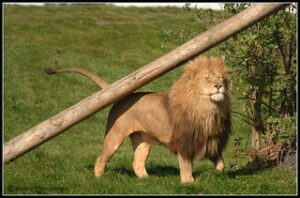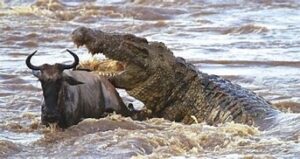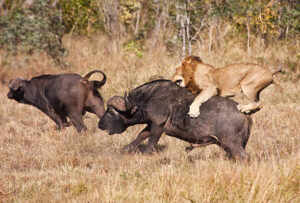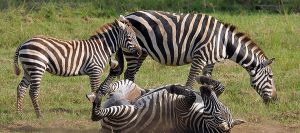The great migration defined as where animal from Serengeti and Masai Mara national park move from place-to-place search for food, water and favorable breeding areas. This migration defines the wildlife resilience to adapt to a continuous changing environment. The migration take place throughout the year moving from a place to place. While wildebeest zebra and gazelles keep on moving from place to place throughout the year. As the wildebeest move, they are closely followed by the predators like Lions, leopard and cheetahs.
Let us get into deeper understanding of this activity that draws millions of people across the global to witness the uniqueness of the nature.
Understanding the Serengeti Ecosystem –
Great migration defined
Before digging into the specifics of great migration, let us first understand the ecological system of Serengeti National Park that necessitate these movements. Serengeti located in northern Tanzania bordering the famous Masai Mara of Kenya. In the same region of northern circuit is where you find Ngorongoro conservation area and Lake Manyara national Park. The ecosystem of Serengeti is made of grassland, woodland, riverine and savannas
The park is characterized by two distinct seasons, one being a dry season and another one a rainy season. A dry season run from may to September characterised by dry weather, limited water, scarce vegetation and cool environment. While the wet season is defined by green vegetation, green vegetation and muddy roads
The seasons are the catalyst of the greater migration. They determine where the food and water can be found and the best breeding environment and time.
The Players: Wildebeests, Zebras, and Gazelles
Herbivores are the major players of this great migration. Herbivores feed on green vegetation therefore their movement is determined by the availability of green grass and water. Therefore, during dry season as the grass dry up and water getting scarce, they move to places where they can find it in plenty. They keep moving following the greenery. As they are moving, they are closely followed by predator resulting into predator prey interaction that keeps in check the population of the park.
Wildebeests-Great migration defined
Wildebeests are perhaps the most emblematic species of the Great Migration, known for their vast herds and distinctive appearance. These ungulates, characterized by their shaggy coats, curved horns, and robust build, play a central role in the ecological dynamics of the Serengeti. Wildebeests are primarily grazers, feeding on the abundant grasses that carpet the plains of the ecosystem.
During the migration, wildebeests form colossal herds that stretch as far as the eye can see, numbering in the hundreds of thousands, if not millions. Their synchronized movements, driven by instinct and environmental cues, create a mesmerizing spectacle that captivates onlookers and wildlife enthusiasts alike.
Zebras-Great migration defined
Zebras, with their distinctive black and white stripes, are another integral part of the Great Migration. These social herbivores graze alongside wildebeests, forming mixed herds that traverse the Serengeti in search of fresh pastures and water sources. Zebras are well-adapted to the challenges of their environment, possessing keen senses and remarkable agility that aid them in navigating treacherous terrain and evading predators.
During the migration, zebras exhibit a remarkable degree of coordination, often positioning themselves strategically within the herd to maximize their safety and access to resources. Their presence adds to the diversity and dynamism of the migration, enriching the tapestry of life that unfolds across the savannas.
Gazelles-Great migration defined
Gazelles, though smaller in size compared to wildebeests and zebras, are no less significant in the grand scheme of the Great Migration. These elegant antelopes, renowned for their speed and grace, form an essential component of the ecosystem’s herbivore community. Gazelles are adapted to both grazing and browsing, allowing them to exploit a wide range of vegetation types within their habitat.
During the migration, gazelles join the ranks of wildebeests and zebras, moving in synchronized herds across the plains. Their agility and vigilance serve as a vital defense mechanism against predators, ensuring their survival amidst the challenges of the journey.
The Cycle of the Great Migration-Great migration defined
The Great Migration is a cyclical phenomenon, characterized by a series of distinct stages that unfold over the course of the year. Each stage is marked by specific behaviours, movements, and ecological dynamics, driven by the interplay of factors such as rainfall, vegetation growth, and predator-prey interactions. Let’s explore the four main phases of the migration:
Calving Season (December to March)
The Great Migration typically begins in the southern Serengeti, where the onset of the rainy season triggers a mass exodus of wildebeests, zebras, and gazelles from their dry-season territories. This period, known as the calving season, is characterized by an abundance of nutritious grasses and water sources, making it an ideal time for herbivores to give birth to their young. Wildebeests, in particular, congregate in large numbers on the nutrient-rich plains of the southern Serengeti, forming massive maternity herds where females give birth to their calves and masse. The synchronized timing of these births is a survival strategy, as it overwhelms predators and increases the chances of individual calves escaping predation.
The calving season is a time of plenty for predators as well, with lions, cheetahs, and hyenas taking advantage of the vulnerable newborns. It’s a period of intense drama and spectacle, as the cycle of life and death plays out on the sun-drenched plains of the Serengeti.
Grumeti River Crossing (April to June)-Great migration defined
As the dry season approaches and the rains begin to wane. The herds of the Great Migration embark on the next phase of their journey. The trek northward towards the Grumeti River. This stretch of the migration route presents formidable challenges. It include long distances, sparse vegetation, and the need to navigate across rivers and water bodies. The Grumeti River, with its meandering channels and treacherous currents, serves as a crucial barrier for the migrating herds. Wildebeests, zebras, and gazelles gather on its banks. Their numbers swelling with each passing day as they prepare for the daunting river crossing ahead.
When the time is right, spurred by instinct and the need for greener pastures. The herds surge forward, plunging into the swirling waters of the Grumeti River. The crossing is fraught with danger, as crocodiles lurk beneath the surface, waiting to ambush unsuspecting prey. Many animals perish in the attempt, succumbing to the swift currents or the jaws of predators.
Maasai Mara Crossing (July to October)-Great migration defined
As the dry season reaches its peak, the herds of the Great Migration continue their northward journey. Crossing into the Maasai Mara National Reserve in Kenya. This phase of the migration is perhaps the most iconic and dramatic. As it involves the perilous crossing of the Mara River. The Mara River, with its deep channels and crocodile-infested waters. Presents a formidable obstacle for the migrating herds. Yet, driven by the promise of fresh grazing grounds and the instinctual urge to keep moving. The animals gather in vast numbers along its banks. Their hooves stirring up clouds of dust as they wait for the opportune moment to cross.
When the signal is given, the herds surge forward, their ranks stretching for miles along the river’s edge. Chaos ensues as animals jostle for position, the air filled with the thunderous sound of hooves and the panicked cries of prey and predator alike. Amidst the chaos, nature’s drama unfolds in all its glory. Crocodiles launch ambush attacks from the depths below, while lions and other predators lie in wait on the opposite bank. Ready to capitalize on any moment of weakness or hesitation.
Return to Serengeti (November to December)
As the short rains begin to fall and the cycle of the seasons completes its course, the herds of the Great Migration turn southward once again. Retracing their steps back to the Serengeti ecosystem. This final phase of the journey is marked by a sense of anticipation and renewal. As the landscape undergoes a transformation in response to the changing weather patterns.
The return journey is not without its challenges. The herds must contend with dwindling resources and the ever-present threat of predators. Yet, spurred on by the promise of fresh pastures and the instinctual drive to reproduce. They press onward, their ranks thinned but their resolve undiminished. As they traverse the vast expanse of the Serengeti, the herds leave behind a trail of hoofprints and memories. A testament to the enduring power of nature’s rhythms and the timeless cycle of life and death.
The Significance of the Great Migration
The Great Migration is more than just a spectacular natural spectacle. It is a cornerstone of the Serengeti ecosystem, shaping its ecological dynamics and sustaining its rich biodiversity. The movement of millions of herbivores across the plains influences a multitude of factors. These includes vegetation patterns, nutrient cycling, and predator-prey interactions.
- One of the key ecological benefits of the Great Migration is its role in nutrient cycling and soil fertility. As the herds graze on the grasslands of the Serengeti, they trample vegetation, depositing dung, This stimulates new growth in the process. This constant cycle of grazing and regeneration enriches the soil, making it more fertile and productive for future plant growth.
- The migration also plays a crucial role in controlling vegetation dynamics within the ecosystem. By consuming large quantities of grasses and other vegetation, the herds prevent any single plant species from dominating the landscape. Promoting biodiversity and ensuring a healthy balance of plant species.
- Furthermore, the Great Migration influences predator-prey dynamics in profound ways. The arrival of millions of herbivores in a particular area attracts a diverse array of predators, including lions, cheetahs, leopards, and hyenas. These predators rely on the abundance of prey during the migration to sustain themselves and their offspring. This leads to heightened levels of predation and competition.
Recomended Packages- Great migration defined
Conclusion-Great migration defined
The Great Migration is a testament to the extraordinary resilience and adaptability of wildlife in the face of environmental challenges. Across vast stretches of savanna and woodland, millions of herbivores undertake an epic journey that spans continents and generations. Driven by instinct and the timeless rhythms of nature.





